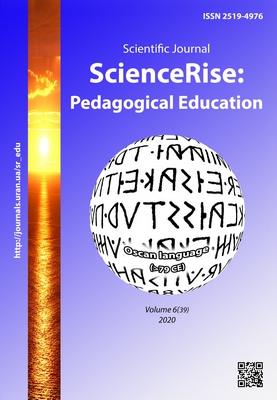State of formation of communicative competence in children of senior preschool age with motor alalia
DOI:
https://doi.org/10.15587/2519-4984.2020.219974Keywords:
communicative competence, children with motor alalia, criteria, indicatorsAbstract
The article highlights the issues of the current state of development of the communicative-speech activity of older preschool children with speech disorders, the article considers the views on the problem of organizing correctional and developmental work with children with motor alalia. The results of the study of the state of formation of communicative competence in older preschool children with motor alalia and children with normotypic speech development are presented.
The analysis of the results of the study of the state of formation of communicative competence in older preschool children with motor alalia confirmed the relevance of the study.
Criteria with the corresponding indicators of formation of communicative competence of the specified category of children are defined, forms of speech (expressive and impressive) with their nonverbal manifestations in communication and communicative skills in various forms of interactive communication acted as criteria.
The levels of formation of communicative competence are highlighted, in particular: high, sufficient, medium and low.
According to the results of the experiment, it was found, that children with motor alalia have a significantly lower level of formation of communicative competence, in contrast to children with normotypic speech development, which leads to the need to create special psychological and pedagogical conditions for the formation of communicative competence in older preschool children with motor alalia, based on modern complex-integration approach in correctional speech therapy work
References
- Bohush, A. M., Havrysh, N. V. (2015). Doshkilna linhvodydaktyka : teoriia i metodyka navchannia ditei ridnoi movy v doshkilnykh navchalnykh zakladakh. Kyiv: Vydavnychyi Dim «Slovo», 704.
- Sheremet, M. K., Pakhomova, N. H. (2009). Formuvannia movlennievoi hotovnosti ditei starshoho doshkilnoho viku z porushenniamy movlennia do navchannia v shkoli. Kyiv: Nats. ped. un-t im. M. P. Drahomanova, 137.
- Bohush, A. M. (2004). Movlennievyi komponent doshkilnoi osvity. Odesa: Yaroslav, 176.
- Kalmykova, L. (2015). Movlennieva diialnist yak skladova chastyna predmeta psykholinhvistyky. East European Journal of Psycholinguistics, 2 (1), 59–67.
- Pirozhenko, T. O. (2013). Komunikatyvno-movlennievyi rozvytok doshkilnyka. Ternopil: Mandrivets, 152.
- Vizel, T. G. (2018). Artikuliatsiia i ee narusheniia: (teoreticheskii aspekt s pozitsii neiropsikhologii). Spetsialnoe obrazovanie, 3 (51), 123–135.
- Pavlova, N. V. (2017). Formuvannia komunikatyvnoi aktyvnosti u nemovlennievykh ditei molodshoho doshkilnoho viku zasobamy innovatsiinykh tekhnolohii. Odesa: DZ «Pivdennoukr. nats. ped.un-t im. K.D. Ushynskoho», 210.
- Sobotovych, Ye. F. (2003). Kryterii otsiniuvannia movlennievoho rozvytku dytyny (u yoho leksychnii lantsi) na riznykh vikovykh etapakh. Defektolohiia, 2, 2–7.
- Zhukovskyy, V. (2017). The role of the teacher in the process of forming the communicative competence of the junior pupils based on the structural approach to personality. ScienceRise: Pedagogical Education, 12 (20), 48–54. doi: http://doi.org/10.15587/2519-4984.2017.120051
- Luriia, A. R. (2000). Vysshie korkovye funktsii cheloveka i ikh narusheniia pri lokalnykh porazheniiakh mozga. Moscow: Izd-vo Akadem. Proekt, 282.
Downloads
Published
How to Cite
Issue
Section
License
Copyright (c) 2020 Inna Baranets

This work is licensed under a Creative Commons Attribution 4.0 International License.
Our journal abides by the Creative Commons CC BY copyright rights and permissions for open access journals.
Authors, who are published in this journal, agree to the following conditions:
1. The authors reserve the right to authorship of the work and pass the first publication right of this work to the journal under the terms of a Creative Commons CC BY, which allows others to freely distribute the published research with the obligatory reference to the authors of the original work and the first publication of the work in this journal.
2. The authors have the right to conclude separate supplement agreements that relate to non-exclusive work distribution in the form in which it has been published by the journal (for example, to upload the work to the online storage of the journal or publish it as part of a monograph), provided that the reference to the first publication of the work in this journal is included.








